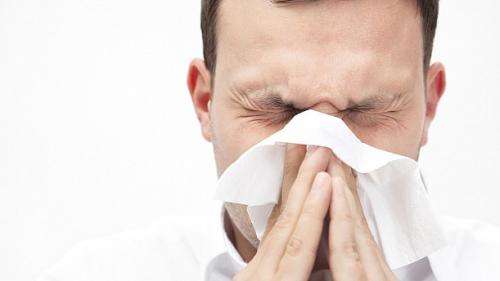Ease allergy symptoms without injections

It's been a winter to remember in the Tristate, complete with snow, ice and sub-zero temperatures. But with temperatures finally warming up, spring is in sight with challenges of its own: seasonal allergies.
Nearly 40 million people suffer from seasonal allergies, also known as hay fever, with symptoms such as a stuffy, runny nose, itchy eyes, and sneezing and wheezing.
"Spring allergy season has been starting a little earlier in recent years and has been a little more severe every year now for a number of years," says Allen Seiden, MD, a professor in the University of Cincinnati (UC) Department of Otolaryngology–Head and Neck Surgery and otolaryngologist (ear, nose and throat specialist) at UC Health.
Seiden says that although the cold winter froze trees, plants and grass and halted their growth, recent heavy rains and warmer weather will speed up pollen production, especially in trees. Pollen, the dust-like, male reproductive part of plants, is dispersed into the air as trees and plants begin to bloom. Trees typically pollinate in late March and early April, followed by grass later in the season.
Additionally, Seiden says, cold weather predicted for later this month might impair pollination, only to result in a rebound once the weather warms again.
"This means those with allergies may start to rev up their allergy response to the first exposure (priming), which is then dampened by the cold, only to really blast out when the exposure recurs," he says.
UC Health Otolaryngology offers sublingual immunotherapy, a convenient way to treat allergies without injections. In sublingual immunotherapy, drops under the tongue are administered to alter the immune reaction.
"Every week the patient takes a tiny dose of the things they are allergic to," explains Seiden. "We increase the dosage a little bit at a time, and then the patient's body gets to know these things as friendly and doesn't try to fight against them."
Seiden recommends taking the following steps to help reduce your exposure and to control symptoms:
- Since the peak hour for pollen dispersal is 5–10 a.m., try to avoid the outdoors during that time. If you do need to be outside, wear a face mask.
- To help remove pollen from skin and hair, shower immediately after being outdoors, and especially before going to bed.
- Wash clothing that has been worn outside in hot water. Do not dry it outdoors.
- Wash bedding in hot water once a week and avoid hanging it outside.
- Keep the windows and doors of your home and car closed. Use an air conditioner to cool the air, not window or attic fans.
"It's important for people to know what they're actually allergic to, so an allergist or otolaryngologist can accurately diagnose and help them manage their condition," says Seiden.
"What works best for one person may not be as effective for another," says Seiden. "That's why it's important to see a doctor before your allergies get out of control."



















